I realize it’s been quite some time since I have posted anything, but I have (what I think is) a good excuse. I’ve been busy living life (instead of posting about it). Ben and I moved to our new house that he’s been working on for the past five years (yay!), I’ve been working a lot of help pay for construction of said house, I launched a new music venture with two of my best friends and music colleagues, and Ben and I squeezed in a lovely vacation to Colorado. The work has been (mostly) fulfilling, but needless to say, it’s left little time to do other things, like write blog posts.
But recently, I’ve been on a bee kick. You’ve heard they’re in a bad way, right? No? Well, there’s this thing called colony collapse disorder, and the super smart science people aren’t certain what causes it, but they think that nasty pesticides have something to do with it (in addition to a number of other factors.)
Ben and I have casually kicked around the idea of keeping bees, but we’re not ready for that commitment, so when my good friend, Chris, came to visit us shortly after we moved into the new house and told us about how we could build our own native bee box, which wouldn’t require much extra work besides building the thing and putting it outside, I got really excited. Yes, yes, I realize that it’s honey bees (and they are non-native to the U.S.) that are affected by colony collapse disorder, but I figured it can’t hurt to help the bee population in general, right?
But seeing as how we just moved and had more pressing things to do (um, yes, I DID need to make sure my linen closet was properly organized RIGHT AWAY), I shelved the bee box idea for the time being.
Then Grid Magazine decided to do a mini-section on bees for their July issue, and I wrote two articles for it–one about the smart beehive my super intelligent and awesome friends, Wynn Geary and Max Lawrence, are building, and one on how to build a native bee box. (Did you know that there are 4,000 species of bees native to U.S.? Because I didn’t until I wrote that article. Also, did you know that some bees are solitary and some are social? Because I didn’t know that, either. You should really read my article and have some bee knowledge dropped on you.)
After that, I was totally on the bee box bandwagon again, and it just so happened that my mom’s birthday was coming up, so I figured there was no time like the present to make a bee box. I didn’t really have the time to do it, but don’t they say something about how if you want something done, give it to a busy person? (Who are those magical “they” anyway?)
So I scoured Pinterest for ideas (and man, are there a bunch of different ways to build a bee box!), picked a general design, laid out some dimensions, and went to the basement to inventory Ben’s stash of scrap lumber, which is ample. I settled on some old, salvaged stair parts for the frame, into which I would add a combination of wood blocks, bamboo pieces and tree limbs cut to right depth. There was a freak big storm here in Philly just a couple weeks before, and Ben had scored me some wood from a downed tree.
I cut the stair parts to length, ripped them down to the right width and nailed them together with the help of a pneumatic nail gun. (Seriously, I love air tools. I don’t know how I ever lived without them. They’re the best!) Ben helped nail the back on because the wood was too hard, and it was making the nails from the nail gun curve and push through the inside of the box. After all that, I had the frame, which was roughly 9 inches wide, 11 inches tall and 5.5 inches deep.
I had bought some bamboo at Home Depot, so I cut it to size (no more than 5.5 inches), but let me tell you, it takes a shit ton of bamboo shoots to fill frame that size. I hadn’t been planning on filling it completely with bamboo anyway, but I thought it might go further than it did. (See photo below…pretty pathetic, huh?)
I cut a bunch random-sized blocks and the tree limbs to the appropriate depth, and then I worked on the layout inside the frame. I tried a few, but the one on the right is the one I settled on.
Then I started the drilling process. For holes smaller that 0.25 inches, you want to drill 3 to 4 inch holes. For holes 0.25 inches or more, the holes are supposed to be 5 to 6 inches. My original plan was to drilled holes of all different sizes, but average drill bits are until somewhere between 2.5 to 3 inches, so most of my holes ended up being less than a quarter-inch. Ben had one extra long drill bit that was exactly a quarter-inch, so all of the deeper holes were only a quarter inch.
There are no photos of this part of the process because it was late, drilling hole after hole was tedious (especially in the relatively “green” tree limb wood), and I may or may not have had a meltdown when Ben asked me if I wanted his help or not after I got a drill bit stuck in one of the limbs, which resulted in my having to cut another one. (Said meltdown may or may not have involved me throwing pieces of wood around the basement.)
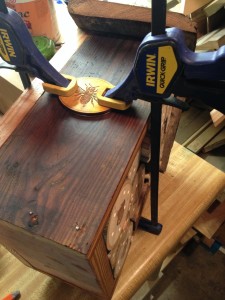 But I did manage to finish the drilling and added the final pieces–laser cut bee medallions that I made at the Department of Making + Doing. I glued them to either side of the box, clamped them overnight and went to bed vowing never to make another damn bee box again.
But I did manage to finish the drilling and added the final pieces–laser cut bee medallions that I made at the Department of Making + Doing. I glued them to either side of the box, clamped them overnight and went to bed vowing never to make another damn bee box again.
The following morning, after my rage had subsided, I reassessed things and determined that the bee box had, in fact, turned out pretty well, and I might even be willing to make one again for myself. I am pleased to say that my mom really liked the box, and it is now placed in the flower garden at the end of her driveway adjacent to her vegetable garden (photo on right below). Lovely, right?
In fact, I have managed to put the pain of building the bee box behind me so effectively that I have agreed to help lead a bee box workshop with Wynn on August 18th at the Department of Making + Doing. The design will be a little different from the one I built, but in addition to building a sweet bee box for your backyard, you’ll also get to learn a little bit about these very important native pollinators.
But regardless of whether you come to the workshop or not, I urge you to learn more about bees and what an important role they play in our food system and ecosystem in general. Maybe you’ll be inspired to build your own native bee box, too!


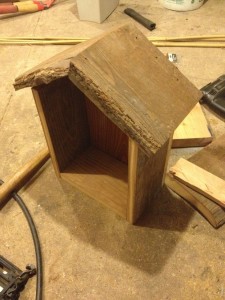
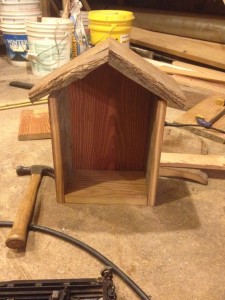
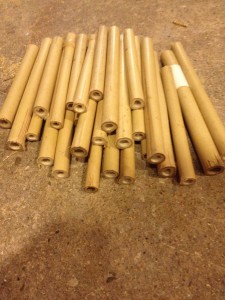
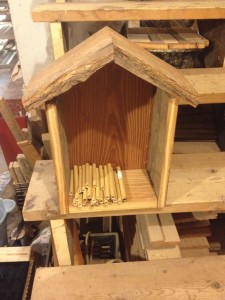
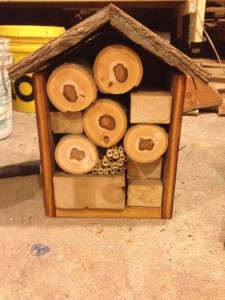
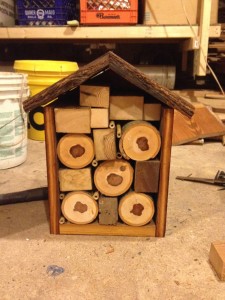
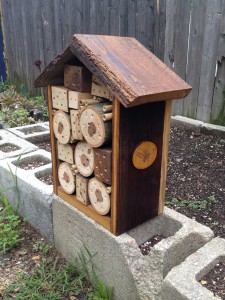
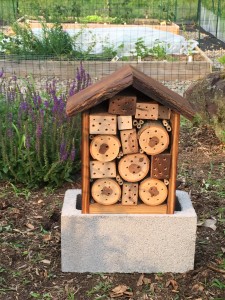
Leave a Comment
Let us know your thoughts on this post but remember to place nicely folks!